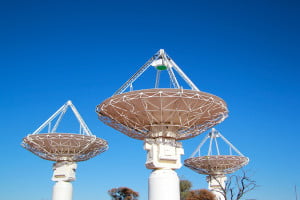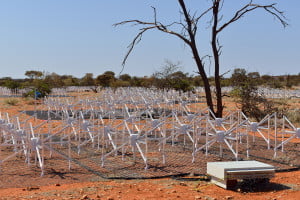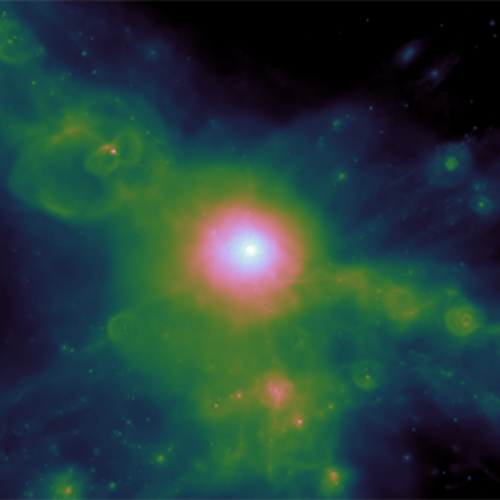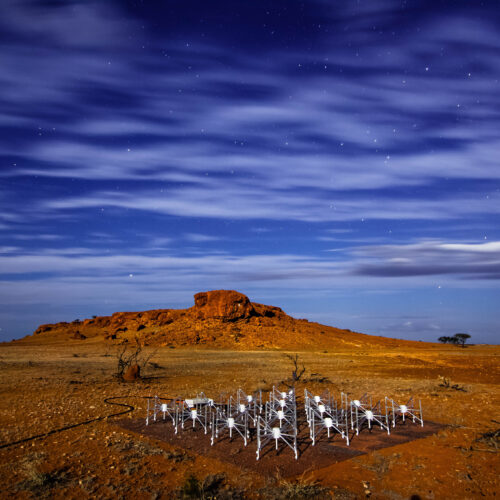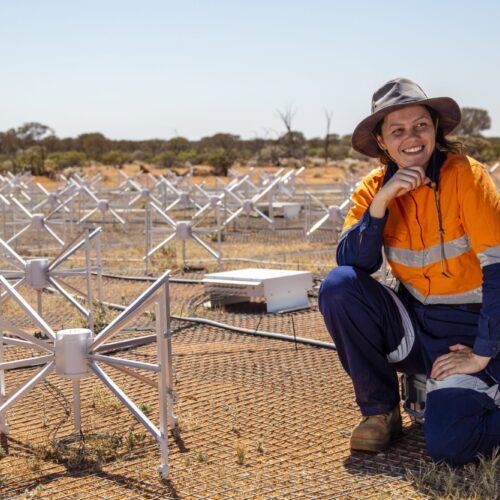SKA precursor* and pathfinder telescopes, including the Australian SKA Pathfinder (ASKAP), the Murchison Widefield Array (MWA) and South Africa’s MeerKAT, will provide crucial design, assembly and deployment guidance for the SKA. On top of this, each precursor instrument is also a world-leading telescope in its own right and will eventually complement SKA observations.
*A precursor to the SKA is defined by the SKA Office as a pathfinder instrument located at one of the future SKA sites.
ASKAP
ASKAP is a high-speed survey instrument consisting of 36 dishes, each 12m in size, in the Murchison Radio-astronomy Observatory (MRO). Development and construction of the pathfinder, led by CSIRO, was completed at the end of 2012 and, during its recent commissioning, it has been producing early science and verification of its rapid survey speed through the Boolardy Engineering Test Array (BETA). ASKAP boasts leading-edge technology, including Phased Array Feeds (PAFs), which will be responsible for giving the SKA mid-high frequency component an extremely wide field of view and rapid survey speed.
Over the next 5 years, ICRAR will play a key role in supporting ASKAP science and data management. ICRAR will focus its efforts on three of ten approved ASKAP surveys: WALLABY and DINGO, both measuring neutral hydrogen gas (HI) – the foundation of stars and galaxies – in up to one million galaxies, whilst CRAFT will search for short-lived bursts of radio waves known as radio transients.
WALLABY
WALLABY (Widefield ASKAP L-band Legacy All-sky Blind SurveY) is an international collaboration led by ICRAR/UWA Science Director Lister Staveley-Smith that will catalogue and map up to half a million galaxies twenty times faster than any previous survey. The survey will measure the most abundant non-dark matter material in the Universe, neutral hydrogen, in up to 75% of the sky to shed light on a number of galactic processes, including –
- Formation, interaction and evolution of galaxies
- Star formation properties in galaxies
- Dependence of neutral hydrogen distributions on galaxy density
- Physical processes driving the distribution and evolution of cool gas in nearby galaxies (up to z=0.26)
- The overarching structure of the Universe.
DINGO
DINGO (Deep Investigation of Neutral Gas Origins) led by ICRAR Research Associate Dr Martin Meyer, will study galaxy evolution over the past 4 billion years (out to a redshift of 0.43). DINGO will conduct deep surveys of neutral hydrogen in around 100,000 galaxies (a small selection of ASKAP fields) with cutting-edge stacking techniques developed by ICRAR scientists to aid detections in distant galaxies. DINGO observations will be combined with the multi-wavelength GAMA (Galaxy and Mass Assembly) survey to separate changes in stellar, baryonic (mostly protons and neutrons) and dark matter in galaxies over the past 4 billion years – the first comprehensive study of its type.
CRAFT
CRAFT (Commensal Real-time ASKAP Fast Transients survey) led by ICRAR Deputy Director Peter Hall, is a project to detect and identify enigmatic ‘Fast Radio Transients’, elusive radio sources that emit on timescales shorter than 5 seconds. These events originate from objects such as neutron stars and black holes and are among the most energetic in the Universe. As well as searching for these mysterious radio sources, CRAFT also offers a unique opportunity to explore the physics of extreme states of matter and gravitational fields that cannot be reproduced in laboratories on Earth.
Murchison Widefield Array (MWA)
The Murchison Widefield Array (MWA) is a low-frequency (70-300MHz) radio telescope at the Australian SKA site, the Murchison Radio-astronomy Observatory (MRO). Fully operational from 2013, the MWA has been developed by an international collaboration, led by Curtin University. The telescope is maintained and remotely operated at the Curtin node of ICRAR.
The MWA consists of 4096 spider-like dipole antennas arranged in 4×4 grids called ‘tiles’. The majority of the tiles are scattered across a roughly 1.5 km core region, forming an array with very high imaging quality, and a field of view of several hundred square degrees at a resolution of several arcminutes. The remaining tiles are placed at distances of up to 6km outside the core to allow even higher angular resolution.
The knowledge and expertise obtained through the development, construction and operation of the MWA is directly applicable to the many science, engineering and computing challenges on the path to SKA-low. The MWA has already explored engineering solutions for low-cost, high-performance antennas, and addressed some of the computing challenges produced by very high data rates and volumes, and large-scale archives.
The MWA has four key science objectives which will both guide and complement SKA science objectives:
- Studies of neutral hydrogen (star formation fuel) distributions from the Epoch of Reionisation – a cosmic period 13 billion years ago when the first stars and galaxies formed;
- Galactic science, including a survey of radio emissions from nearby sources low in the Southern Hemisphere sky. These detections provide an opportunity to both calibrate Epoch of Reionisation observations, by measuring foreground noise, and to study galactic and nearby extragalactic sources themselves;
- Detection of radio transients with timescales from seconds to days (longer timescales than the objects at the focus of the ASKAP CRAFT survey); and
- Space weather, including the study of solar burst properties through solar heliosphere and ionosphere (SHI) imaging.
MeerKAT
MeerKAT is the mid-frequency SKA precursor under construction in South Africa’s Karoo Desert. When complete, that array will contain 64 dish antennas, each 13.5m diameter. Eventually MeerKAT will be integrated into the SKA’s mid-frequency infrastructure and will provide both wide-view and high-resolution images. In a similar configuration to the MWA, 75% of MeerKAT dishes will be within a 1km diameter and the remainder in spiral arms extending out to 8km.
MeerKAT will support eight key science objectives, in addition to enhancing the sensitivity of the global Very Long Baseline Interferometer (VLBI) operations. The two priority MeerKAT science objective are:
- Radio pulsar timing to validate Einstein’s theory of relativity, including evidence for gravitational waves, and to analyse the physics of neutron stars; and
- LADUMA (Looking at the Distant Universe with the MeerKAT Array), a deep survey of neutral hydrogen which will look at more distant galaxies than any previous survey (including ASKAP’s WALLABY and DINGO surveys).
